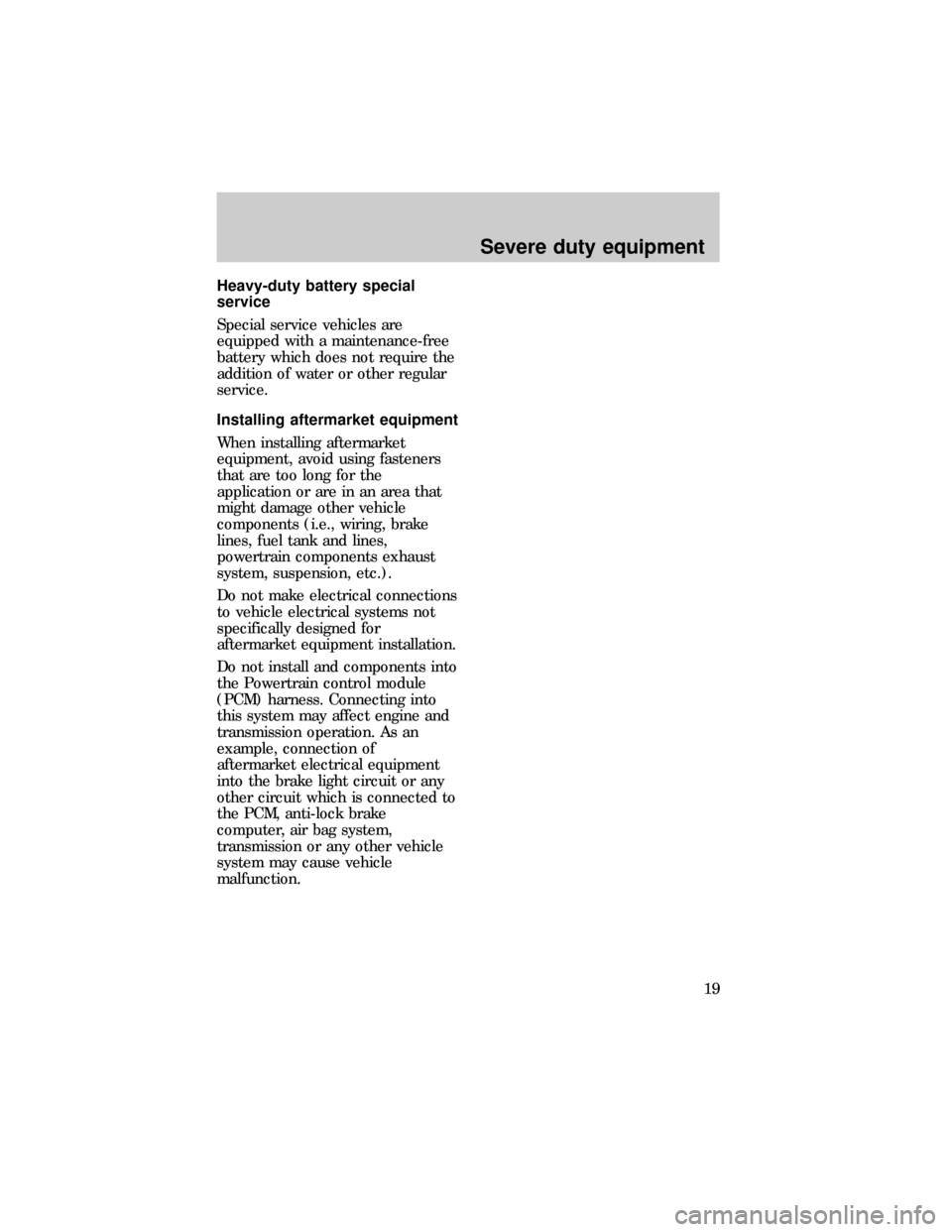Page 5 of 28

Battery cables and connections5,000 km (3,000 miles)
or every three months
Fluid leaks5,000 km (3,000 miles)
or every three months
Brake fluid level5,000 km (3,000 miles)
or every three months
Front disc brake pads5,000 km (3,000 miles)
or every three months
Rear disc brake pads10,000 km (6,000
miles) or every six
months
IMPORTANT MAINTENANCE
PRECAUTIONS
For more information on
maintenance procedures and
precautions for your vehicle, refer
to theMaintenance and care
chapter of your ªOwner Guideº.
To determine the lubricant
specifications required for each
component, refer to the
Capacities and specifications
chapter of the ªOwner Guideº.
Storing your vehicle
During extended periods of vehicle
storage (60 days or more),
oxidation may cause gasoline to
deteriorate. Such deterioration
could be detrimental to your
vehicle's systems and performance.
A commercial fuel stabilizer (Ford
Gas Stabilizer E8AZ-19C544±A
[ESE-M99C112±A] or equivalent
should be added to vehicles when
Maintenance recommendations
5
Page 14 of 28

POWER STEERING FLUID
Check the level of the power
steering fluid at least twice per
year. The fluid level may be
checked when the fluid is either
HOT or COLD.
Use only Ford Premium Power
Steering Fluid E6AZ-19582±AA or
an equivalent Type F fluid that
meets Ford specification
ESW-M2C33±F and has a Ford
registration number ( an eight digit
number beginning with 2P) printed
on the fluid container.
For more information on power
steering maintenance, refer to
Checking and adding power
steering fluidin theMaintenance
and carechapter of the ªOwner
Guideº.
ELECTRICAL SYSTEM AND
IGNITION MAINTENANCE
Battery and cables
Visually inspect the battery and
battery cables every three months
or 5,000 km (3,000 miles),
whichever occurs first. Any signs
of corrosion on the
cable-to-battery post connections,
battery case or carrier should be
removed with a baking soda and
water solution. Be sure that none
of the cleaning solution enters the
battery through the vent openings.
Rinse with clean water and dry
thoroughly. Apply a small quantity
of Ford Silicone Lubricant or an
MAX
MIN
DONOTOVERFILLPOWERSTEERINGFLUID
Maintenance recommendations
14
Page 15 of 28

equivalent that meets Ford
specification ESR-M13P4±A to the
terminal surfaces to help prevent
corrosion from forming.
Check the tightness of the cables
to the battery post by hand. It may
be necessary to tighten the clamp
with a suitable wrench.
Ignition system
Visually inspect the plug wires and
ignition coil pack. Any oily dirt
should be removed and the area
cleaned with a damp cloth. Ensure
that all high voltage wires are
firmly attached to the coil pack
and that the other ends are firmly
seated over each spark plug.
Other electrical systems
Wiring, lighting and aftermarket
electrical equipment should be
checked monthly for proper
routing, deterioration or chafing on
other components.
UNDER VEHICLE
MAINTENANCE
Catalytic converters
During normal engine operation,
the catalytic converter surface
temperature can reach up to 816ÉC
(1500ÉF). To avoid injury, ensure
that the converter has cooled
before attempting maintenance.
Ford recommends that an under
vehicle inspection be performed at
Severe Dutyintervals listed in the
ªService Guideº. With the vehicle
Maintenance recommendations
15
Page 19 of 28

Heavy-duty battery special
service
Special service vehicles are
equipped with a maintenance-free
battery which does not require the
addition of water or other regular
service.
Installing aftermarket equipment
When installing aftermarket
equipment, avoid using fasteners
that are too long for the
application or are in an area that
might damage other vehicle
components (i.e., wiring, brake
lines, fuel tank and lines,
powertrain components exhaust
system, suspension, etc.).
Do not make electrical connections
to vehicle electrical systems not
specifically designed for
aftermarket equipment installation.
Do not install and components into
the Powertrain control module
(PCM) harness. Connecting into
this system may affect engine and
transmission operation. As an
example, connection of
aftermarket electrical equipment
into the brake light circuit or any
other circuit which is connected to
the PCM, anti-lock brake
computer, air bag system,
transmission or any other vehicle
system may cause vehicle
malfunction.
Severe duty equipment
19